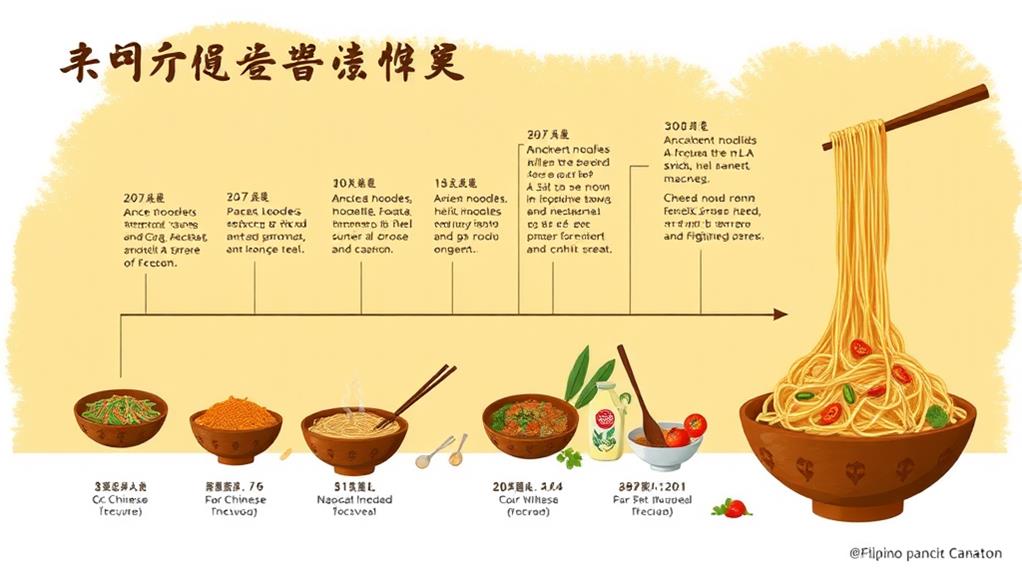Filipino Pancit Canton originated from Chinese lo mein, introduced by Chinese immigrants in the 16th century. This dish evolved over time through significant adaptations, incorporating local ingredients and cultural exchange, to become a distinctly Filipino culinary staple.
Pancit Canton is a traditional street food in the Philippines, symbolizing long life and prosperity. It is commonly served at celebrations, such as birthdays and weddings, as a symbol of good fortune and long life.
Regional variations of Pancit Canton exist, with different parts of the Philippines incorporating local ingredients. For example, in the Visayas region, Pancit Canton is often served with seafood, while in the Luzon region, it is typically served with vegetables and meat.
Instant noodle versions of Pancit Canton have also been developed, making it more accessible and convenient. This has contributed to its widespread popularity, not only in the Philippines but also around the world.
Pancit Canton represents a rich cultural heritage, shaped by the cultural exchange between the Philippines and China. It is a testament to the country's ability to adapt and incorporate foreign influences into its own unique culinary identity.
Origins of Pancit Canton

Pancit Canton originated from Chinese lo mein, brought by Chinese immigrants to the Philippines in the 16th century. These immigrants introduced their culinary traditions, including a stir-fry noodle dish that would eventually evolve into Pancit Canton.
This dish underwent significant adaptations to become a distinctly Filipino culinary staple.
Traditionally, Pancit Canton is made with wheat egg noodles. Its rich flavor and versatility allow it to feature a variety of meats, vegetables, and sauces. Over time, it gained popularity as a street food staple and became a common feature at celebrations, especially birthdays, symbolizing long life.
Filipino cooking practices shaped Pancit Canton, influencing and being influenced by regional variations and modern adaptations. The dish has been defined by cultural exchange, blending Chinese and Filipino flavors.
Understanding the origins of Pancit Canton provides a fascinating glimpse into this cultural exchange. By tracing its roots, you'll appreciate the unique blend of flavors that have made Pancit Canton a beloved dish in the Philippines.
Cultural Significance and Variations
Pancit Canton's Cultural Significance
Pancit Canton holds a profound cultural significance in Filipino celebrations and everyday life, symbolizing long life and prosperity. It is often served during birthdays and festive gatherings, showcasing the adaptation of Chinese culinary techniques in Filipino cuisine.
Regional Variations
Regional variations of Pancit Canton can be found throughout the Philippines, incorporating local ingredients like seafood or unique sauces and garnishes.
For example, in coastal regions, seafood such as shrimp or fish is added to the dish, reflecting the country's diverse culinary landscape.
Convenience and Tradition
The popularity of Pancit Canton has led to the emergence of instant noodle versions, catering to modern convenience while honoring traditional flavors.
These instant versions are a convenient alternative to traditional cooking methods, allowing Filipinos to enjoy the dish quickly and easily.
Enduring Cultural Significance
Pancit Canton remains a staple in Filipino households, often enjoyed as a quick meal that's both convenient and flavorful.
Its cultural significance continues to grow with each delicious serving, solidifying its place in Filipino cuisine and celebrations.
Evolution of Filipino Noodles

The Evolution of Filipino Noodles
Cultural Exchange and Adaptation
Filipino noodles, particularly Pancit Canton, have a rich history of cultural exchange and adaptation. Chinese traders introduced lo mein to the Philippines in the 16th century, which eventually evolved into Pancit Canton. The term "pancit" comes from the Hokkien phrase "pian i sit," meaning "convenient food," due to the quick cooking methods of noodles.
Adapting to Filipino Tastes
Unlike its Chinese counterpart, Pancit Canton was adapted to Filipino tastes, featuring a mix of meat, vegetables, and a rich sauce.
During the Spanish colonial period, Pancit Canton's popularity grew, becoming a staple in local eateries known as panciterias.
Cultural Significance
Today, Pancit Canton is a beloved dish in the Philippines, commonly served during festive occasions. It symbolizes both cultural fusion and community celebration, representing the country's cultural heritage by blending Chinese, Spanish, and local influences.
Regional Pancit Dishes and Traditions
Regional Variations of Pancit Canton
Across the Philippines, local cooks have created unique regional variations of Pancit Canton, showcasing their creativity and resourcefulness.
These variations reflect the diversity of Filipino communities and highlight the versatility of Pancit Canton.
Regional Adaptations
Different regions in the Philippines have developed their own signature Pancit Canton dishes, each with unique features.
- Cebu's Pancit Bam-I: Combines bihon and canton noodles for a distinct texture.
- Ilocos' Pancit Candon: Features carabao meat and local vegetables, giving it a distinct flavor profile.
- Laguna's Pancit Langlang: Uses a sweet and savory sauce made with soy sauce and vinegar, adding depth to the dish.
- Pampanga's Pancit Lugaw: Adds a rich and creamy broth made with pork and chicken stock, making it a hearty option.
Common Characteristics
These regional adaptations often feature a vibrant mix of ingredients, including soy sauce, garlic, and fresh produce from the region.
They are commonly served during festive occasions like birthdays and weddings, symbolizing long life and prosperity.
Modern Adaptations and Accessibility

The modern era has brought about a new wave of Pancit Canton adaptations, catering to the evolving tastes and lifestyles of contemporary consumers.
Accessibility has increased with the availability of instant noodle versions of Pancit Canton in supermarkets, making it a convenient option for those with busy schedules.
Additionally, many restaurants now offer creative twists on the traditional recipe, incorporating local ingredients and flavors to suit modern tastes.
Modern adaptations of Pancit Canton include:
Seafood options, where many restaurants now offer seafood-infused Pancit Canton, adding a fresh twist to the classic dish. For instance, some restaurants add shrimp, scallops, or mussels to give it a seafood flavor.
Health-conscious variations, where quinoa or whole grain noodle versions of Pancit Canton cater to health-conscious diners. This adaptation provides a nutritious twist on the traditional recipe.
Online accessibility, where online recipe platforms and cooking shows have made it easy to recreate Pancit Canton at home, with step-by-step guides and tutorials. This allows individuals to learn and prepare the dish in the comfort of their own homes.
Convenient delivery, where food delivery services have made it possible to enjoy Pancit Canton without extensive preparation, making it a popular choice for casual dining and celebrations. This option saves time and effort, making the dish more accessible to a wider audience.
These modern adaptations haven't only made Pancit Canton more accessible but also more exciting, with new flavors and ingredients to explore.
Preserving Cultural Heritage
Pancit Canton: A Dish of Cultural Significance
Pancit Canton is a beloved Filipino dish that reflects the blending of Chinese and Filipino culinary traditions. This fusion of cultures occurred when early Chinese settlers introduced their cooking techniques to the Philippines. The preparation of Pancit Canton involves using egg noodles, which symbolize the fusion of local ingredients with Chinese cooking methods.
Pancit Canton is commonly served during celebrations, especially birthdays, as it embodies the Filipino tradition of wishing for long life and prosperity. The dish's cultural significance is maintained through its various regional adaptations, allowing communities to incorporate local flavors and ingredients while honoring the original dish.
Cultural practices surrounding Pancit Canton, such as not cutting the noodles, highlight the importance of preserving the symbolism of longevity and good fortune in Filipino heritage. This tradition emphasizes the importance of preserving cultural heritage and respecting the dish's origins.
Frequently Asked Questions
What Is the Story Behind Pancit Canton?
Pancit Canton's Origins
Pancit Canton originated in the 16th century when Chinese immigrants introduced various noodle varieties to the Philippines. This introduction led to the development of regional differences in the dish, shaped by unique cooking techniques and ingredient influences.
Cultural Adaptations
Pancit Canton is a festive staple, often served at birthdays and gatherings.
Over time, cultural adaptations have reflected family recipes and health considerations, resulting in variations of the dish.
Traditional serving traditions still hold strong, despite the availability of instant noodle versions.
What Is the History of Pancit in the Philippines?
Pancit in the Philippines has a rich history shaped by cultural influences and regional specialties.
The dish originated from the Chinese stir-fry noodles, which were introduced to the Philippines by Chinese immigrants. Over time, Filipino cooks adapted the recipe to create their own versions using local ingredients and cooking methods.
Today, there are various types of pancit, each with its own unique cooking method, such as stir-fried pancit canton and boiled pancit lugaw.
Pancit evolved from a humble street food to a celebration staple.
In the past, pancit was sold as a cheap snack by street vendors. However, as the dish gained popularity, it became a staple in Filipino celebrations, such as birthday parties and fiestas.
The evolution of pancit reflects the historical influences of Chinese, Spanish, and American cultures on Filipino cuisine.
Ingredient sourcing and family recipes are essential to the cultural significance of pancit.
Filipino cooks take pride in sourcing ingredients from local markets and using family recipes passed down through generations.
Fresh vegetables, meat or seafood, and noodles made from rice flour or egg are common ingredients used in pancit recipes. The dish is often served during special occasions, and its preparation is a way of showing love and respect for family and friends.
Pancit has become a culinary identity that's uniquely Filipino.
The dish has become an integral part of Filipino culture, reflecting the country's history, traditions, and values.
Pancit is a symbol of Filipino hospitality, warmth, and generosity, and its cultural significance continues to grow as Filipino cuisine gains recognition worldwide.
Why Is Pancit Important to the Filipino Culture?
Pancit holds significant cultural importance in the Philippines. It represents longevity and is often served at cultural celebrations and family gatherings. This dish showcases the country's rich culinary heritage, with regional variations and traditional recipes.
For example, the Ilocos region is known for its "pancit miki," which uses thin, flat noodles, while the Kapampangan region has its own "pancit luglug," made with thick, round noodles.
Pancit brings people together, fostering community bonding and emphasizing hospitality and generosity. Its presence at festive occasions, such as birthdays and weddings, reinforces the importance of family ties and community connections.
This is why pancit is an integral part of Filipino identity, representing the country's values and traditions.
Is Pancit Canton Chinese or Filipino?
Pancit Canton is a fusion dish with both Chinese and Filipino influences. This noodle dish originated from Chinese cuisine, but Filipino culinary adaptations have made it unique.
Filipino cooking techniques have evolved to create distinct flavor profiles, resulting in regional variations.
Pancit Canton has become a staple in Filipino festive dishes, symbolizing the significance of meals and cultural adaptations.
It can be found in street food and family recipes, showcasing the best of both culinary worlds.
